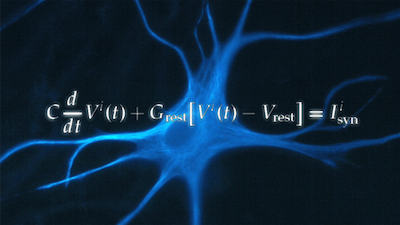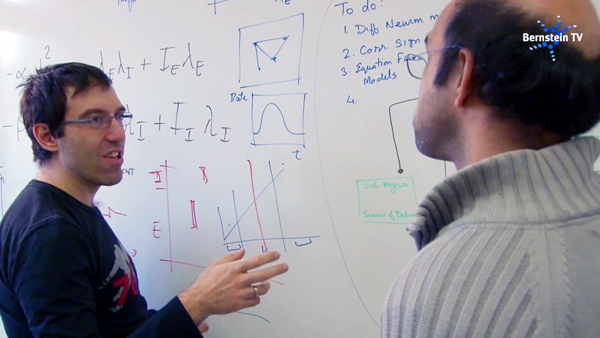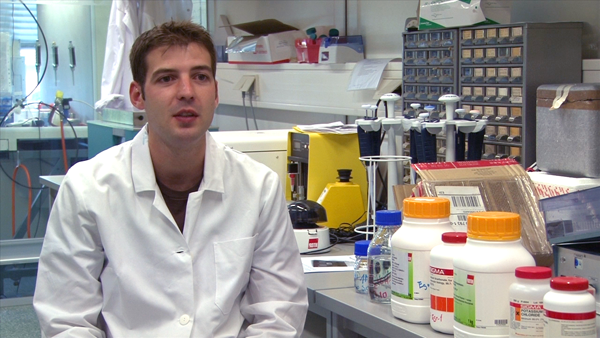Movies and Podcasts
Do you want to know what computational neuroscience and neurotechnology is all about? Or perhaps you want to keep up to date with current research in this field?
On this site, you find the films and podcasts that we have produced so far to address these topics.
At the Bernstein Conference 2011, Berlin-based artist Rainer Dunkel and scientists from the BCF presented for the first time the interactive art installation sensory neuronal network. You can read more about this project here.
Movies
 What is Computational Neuroscience? (4'10'' / 4'16'')
What is Computational Neuroscience? (4'10'' / 4'16'')
- in English
- in German
- in Norwegian
- in Portuguese
- in Finnish
- in Amharic
- in Italian
BCF research on video
 NEST:: documented (12'20'')
NEST:: documented (12'20'')
- in English
- in German
Documentary film on the simulation software and the people behind it.
A short version has been published as an episode of "Bernstein TV".
Crippling rhythms of Parkinson (5'55'') 
- in English
- in German
The Neuron's Footprint - Electrical activity analysis 
in living nerve cells (5'05'')
- in English
- in German
Precise Signals - Coding in the cerebral cortex (3'54'')
- in English
- in German
NeuroVision Film Contest

At the Bernstein Conference 2011 in Freiburg, this international award for short films from the neurosciences was handed out for the first time. Read more about the contest, the participating films and the winners here.
Podcasts

Here, we discuss current developments in the field of theoretical neuroscience, both from members of the BCF and beyond. This podcast is an attempt to explain complex theoretical ideas and their implication in understanding brain function to an audience that reaches beyond the direct scientific community. In regular editions, the hosts Arvind Kumar and Jannis Vlachos will summarize recent publications. When possible, they will be joined by the authors of those papers. Occasionally, we will present special editions with a differing concept. The podcasts are coordinated by Gunnar Grah.
Podcast 03 (Length: 00:22:04)
This time, we look at one one of the paradigms under which the brain can be understood and explored: as a network in which neurons act as "nodes" and their connections, the synapses, act as "links". This time, we are joined by BCF director Stefan Rotter and talk about the mathematical analysis of network structures from their beginnings as random graph models (Stefan mentions the Erdős–Rényi model) to current research. In this respect, Stefan introduces us to a recent article that he co-authored, How Structure Determines Correlations in Neuronal Networks.
Podcast 02 (Length: 00:16:37)
In our second issue, we take a step back and tackle a few very basic questions: What is Computational Neuroscience? Why bother to create models of brains, and how does one carry this out? What kind of contribution can this field of research make to neuroscience in general?
We hope you enjoy this new installment, and are always glad to receive feedback.
Podcast 01 (Length: 00:19:37)
In this very first edition, we are still struggling with the acoustics, but more importantly, we discuss two papers. The first one deals with the development of mathematical tools to study the dynamics of biological neural networks. The second looks into the stability of biological neural networks. Arvind and Jannis will talk to the authors of these two papers, fellow BCF members Stefano Cardanobile and Sarah Jarvis to find out more about the importance of these two papers in the field of theoretical neuroscience.
Stefano Cardanobile presents his article
[00:02:15]
Cardanobile, S. & Rotter, S. (2010) Multiplicatively interacting point processes and applications to neural modeling. J Comput Neurosci 28 : 267-284 [pdf] [PubMed] [DOI]
and Sarah Jarvis talks about
[00:10:08]
Jarvis, S.; Rotter, S. & Egert, U. (2010) Extending stability through hierarchical clusters in echo state networks. Front Neuroinformatics 4 : [pdf] [PubMed] [DOI]
Enjoy this first installment, and we hope that you will check in again.
Podcast title music: "Faster Does It" by Kevin MacLeod

